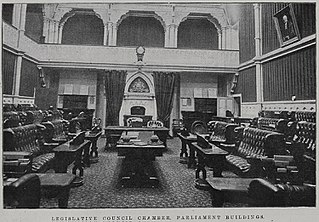Carey John Carrington, Jr. MLC (1877 – 14 December 1966) [1] was a member of the New Zealand Legislative Council from 17 June 1926 to 16 June 1933; then 17 June 1933 to 16 June 1940, when his term ended. He was appointed by the Reform Government. [2]

The Legislative Council of New Zealand existed from 1841 until 1951. When New Zealand became a colony in 1841 the Legislative Council was established as the country's first legislature; it was reconstituted as the upper house of a bicameral legislature when New Zealand became self-governing in 1852.
The Reform Government of New Zealand was the government of New Zealand from 1912 to 1928. It is perhaps best remembered for its anti-trade union stance in the Waihi miners' strike of 1912 and a dockworkers' strike the following year. It also governed during World War I, during which a temporary coalition was formed with the Liberal Party.
He was born in Auckland in the spring of 1877, [3] the eldest son of Carey John Carrington, Sr., who had been born in 1844 in Wokingham, Berkshire, [4] and Alicia Mary Josephine Lonergan. In 1903, he married Elizabeth McCashin. [5] He died in Tauranga in 1966 and is buried in Thames Valley. [6]

Auckland is a city in the North Island of New Zealand. Auckland is the largest urban area in the country, with an urban population of around 1,628,900. It is located in the Auckland Region—the area governed by Auckland Council—which includes outlying rural areas and the islands of the Hauraki Gulf, resulting in a total population of 1,695,900. A diverse and multicultural city, Auckland is home to the largest Polynesian population in the world. The Māori-language name for Auckland is Tāmaki or Tāmaki-makau-rau, meaning "Tāmaki with a hundred lovers", in reference to the desirability of its fertile land at the hub of waterways in all directions.

Wokingham is a historic market town in Berkshire, England, 39 miles (63 km) west of London, 7 miles (11 km) southeast of Reading, 8 miles (13 km) north of Camberley and 4 miles (6.4 km) west of Bracknell. At the 2011 census, it had a population of 30,690.

Berkshire is one of the home counties in England. It was recognised by the Queen as the Royal County of Berkshire in 1957 because of the presence of Windsor Castle, and letters patent were issued in 1974. Berkshire is a county of historic origin, a ceremonial county and a non-metropolitan county without a county council. The county town is Reading.








